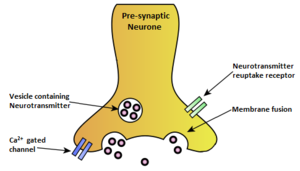Neurotransmitter
Neurotransmitters are chemicals that transmit signals from a neurone to a target cell across a synapse. They are stored in chemical packages known as vesicles and are found in the end of the neurone. Upon arrival of an action potential, neurotransmitters are released into the synapse where they then diffuse and bind to receptors on the post-synaptic neurone.
Types of neurotransmitter
Neurotransmitters can be classified as one of four different types, shown below with examples:
- Amino Acids: glutamate, aspartate, glysine, GABA.
- Monoamines: dopamine, serotonin, histamine, noradrenaline.
- Peptides: substance p, opioid peptides.
- Others: acetylcholine, adenosine, nitric oxide.
Excitatory and inhibitory effects
The direct effect of a neurotransmitter is to activate a receptor. A receptor is typically located on the surface of a neuron, and each type of receptor produces an excitatory or inhibitory effect on that neuron. A neurotransmitter can activate the receptor to produce excitatory effects upon the neuron, which increases the probability that the neuron will fire an action potential. An example of this is glutamate and the majority of its receptors. On the other hand, a neurotransmitter can activate a receptor to produce inhibitory effects on that neuron, decreasing the probability that the neuron will fire an action potential. For example, GABA has an inhibitory effect on most of its receptors. Some neurotransmitters, such as acetylcholine, target both excitatory and inhibitory neurons.
Typical neurotransmitter effects
Here are some examples of important neurotransmitter actions:
- Glutamate is used at most synapses requiring a fast excitatory response and at "modifiable" synapses, which are thought to be the brain's main memory-storage units. Excessive release can cause death.
- GABA is used at most synapses requiring a fast inhibitory response. Many sedative drugs act via GABA.
- Acetylcholine is the transmitter connecting motor neurons to muscle. It also acts on the nicotinic and muscarinic systems.
- Dopamine plays a massive role in the brain's reward pathways as well as regulating motor behaviour, motivation and arousal. High levels of dopamine have been linked to schizophrenia.
- Serotonin has been linked to the regulation of appetite, sleep, memory and learning, temperature, mood, behaviour, muscle contraction and the function of the cardiovascular system. Low levels of serotonin have been linked to depression.
- Substance P is the neurotransmitter responsible for sending pain signals from sensory neurons to the central nervous system.
- Opioids act within the pain pathways and emotional centres of the brain. Some act as painrelievers and produce euphoric effects.
See also
External links
References
This article does not cite enough references. You can help by adding some. |
